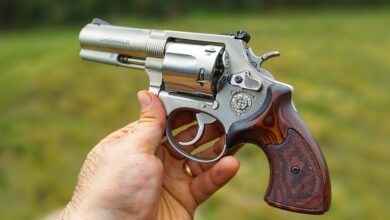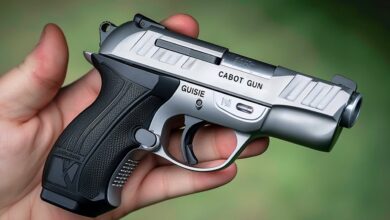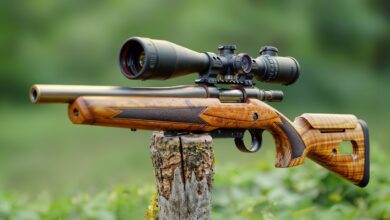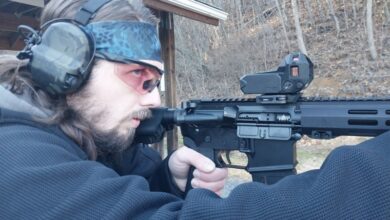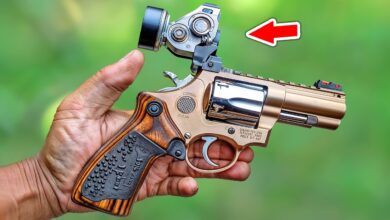A Crash Course in Trigger Types and Styles
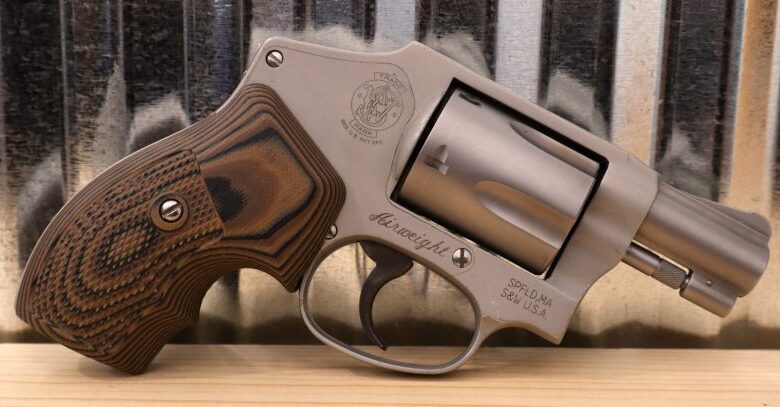
Modern firearms are as diverse as ever. As SHOT Show comes and goes every year, new manufacturers and models are introduced en masse with various options and variations. Despite all this diversity, all firearms have at least one thing in common — a trigger. While most triggers appear the same, they can vary significantly depending on the firearm’s design and purpose.
While this topic may seem introductory to some, many newcomers to the gun world are confused by the terminology and operation of firearm triggers. Depending on the firearm’s action and design, there are hundreds of slight trigger variations. However, most of those variations easily condense into some basic categories. Whether you’re a subject matter expert or just stepping into the gun world, here’s a crash course on the basic handgun and rifle trigger types that can hopefully serve as a future reference.
Handgun Trigger Types
Most modern handgun actions are either revolvers or semi-automatic. Revolvers use a cylinder that rotates within the firearm’s action while semi-automatics feed from a spring-loaded magazine. When it comes to triggers, there’s a significant amount of overlap between trigger types that aren’t exactly unique to semi-automatic handguns or revolvers.
Double Action
Double-action triggers conduct two actions when pressed: the hammer is cocked and released during a single trigger pull. Hence, it is a double action. Most modern revolvers are double-action, especially those with internal hammers. Some semi-automatic handguns are “double-action-only”, which means every press of the trigger cocks and releases the hammer to discharge a cartridge.
This design shouldn’t be confused with a double-action/single-action design, which I’ll discuss later. The trigger always cocks and releases the hammer. This produces a consistent trigger pull that doesn’t vary from shot to shot. However, it does create a heavier pull. Double-action firearms require a significant amount of force, some over 10 pounds, to rotate the hammer back and release it in a trade-off for consistent pull weight.
Single Action
Single-action triggers only conduct one action — they release the hammer from a cocked position. For revolvers, this design evokes memories of the days of Wyatt Earp and Wild Bill Hicock. As the name implies, some current production revolvers, like the Ruger Single Six, are single-action wheel guns.
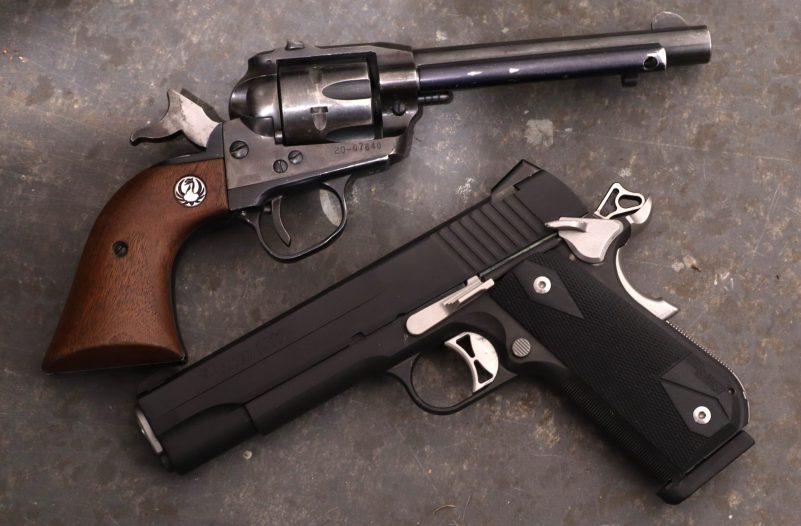
Semi-automatic single-action firearms are often carried “cocked-and-locked”. This style of semi-auto carries with the hammer cocked and an external manual safety engaged. In the case of the 1911 platform, a grip and manual frame safety prevent unintentional discharge.
If you haven’t already performed some deductive reasoning, single-action firearms have shorter trigger movements. While some have triggers as light as a few pounds, the shorter trigger movement produces a perceived lighter pull than most double-action firearms. A six-pound trigger may seem lighter than it really is because the shooter doesn’t have to work their finger over as great of a distance to fire the handgun.
Double-Action/ Single-Action
If there are single-action and double-action firearms, producing handguns that combine the two would only make sense. Double-action/single-action (DA/SA) firearms incorporate design elements from their single and double-action-only counterparts. Most modern hand ejector or swing-out cylinder revolvers have an external hammer that allows the shooter to fire double action or, if they cock the hammer, single action.

Where DA/SA revolvers require manual manipulation of the hammer to engage single-action, this isn’t necessarily the case with DA/SA semi-automatic handguns. DA/SA semi-autos normally include some external de-cocker. When first chambered, the hammer is cocked. The de-cocker disengages the hammer into a resting “half-cock” position that acts as a passive safety. The first shot is fired from double-action. The slide’s ejection of the spent casing and chambering of a live cartridge also cocks the hammer, which converts the gun to single-action operation. DA/SA semi-auto triggers take some getting used to since the first shot has a far greater pull weight than each subsequent shot. Inexperienced shooters often pull the first shot low due to the heavier initial trigger press.
Striker
Striker-fired handguns employ a similar concept as the double-action design. However, the trigger press cocks and releases a striker or firing pin in a linear motion, whereas double-action designs rotate a hammer from forward to cocked. Since the process is linear with striker guns, the pull weight is normally in the four to six-pound range as opposed to eight or more pounds with double-action firearms. The resulting trigger pull is long and consistent, like a double action, but far more manageable.

Long Gun Trigger Types
Long gun trigger types fall into basic categories, similar to handguns. While the actual internal operation may vary significantly depending on the firearm, most long gun triggers fit into basic categories based on their staging or perceived feel.
Single-Stage
Single-stage triggers are somewhat analogous to single-action handgun triggers. Due to the shorter travel distance, the pull weight may seem lighter than it actually is. However, this category of triggers varies wildly depending on the trigger design and the firearm. For example, Timney Triggers offers a wide selection of single-stage triggers for the Remington 700 and AR-15 platforms.
While a single-stage bolt-action trigger may feel crisp and short, a single-stage combat trigger on an AR-15 may have felt “creep” before the sear disengaged and the hammer fell. This doesn’t necessarily change it from the single-stage category; however, it does make a huge difference in perceived feel and can negatively affect accuracy.
Two-Stage
The two-stage trigger appears in many forms. The Savage Accu-Trigger is one of the most prevalent two-stage designs on the market today. The trigger has a lighter initial stage that the shooter presses through before encountering a sudden wall with increased pull weight. Once the shooter applies additional pressure at that wall, the shot breaks.
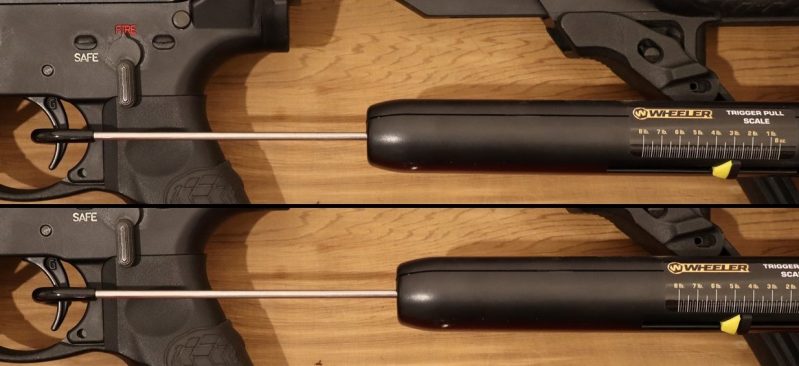
The greatest benefit of the two-stage design is, that it feels far lighter than the actual overall pull weight. For example, a two-stage design may have a six-pound pull for the first stage with an eight-pound pull for the second stage. While a single stage would feel like an eight-pound trigger, the two-stage design already has six pounds of constant pressure applied before the second stage. Since you’re already at six pounds of pressure, you only need to apply two additional pounds to fire. Hence, the perceived pull weight is only two pounds. This design is inherently safer because of the heavier overall pull weight. Geissele, for example, has built a tremendous reputation on the AR-15 platform with their two-stage design.
Set Triggers
While uncommon, set triggers occasionally pop up from time to time in long-range competition and some hunting platforms. A set trigger may have one or two triggers. When the firearm is in a cocked position, the shooter either pulls the second trigger (if two triggers) or pushes the trigger forward (if one trigger) to “set” it. This action engages a sear that significantly reduces the pull weight to a couple of pounds or less.
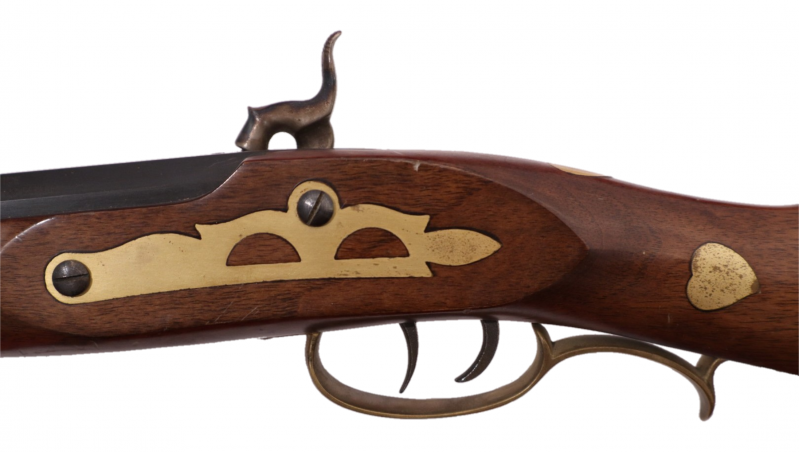
Which is best for you?
Life is pretty boring without variety. While I’ve grown favorable and accustomed to striker-fired triggers on a pistol, it doesn’t mean I don’t enjoy the feel of a good double-action revolver or 1911 single-action trigger. The preference for a given trigger style is about personal wants and needs. Ultimately, the choice is yours. There’s definitely no shortage of options!
The post A Crash Course in Trigger Types and Styles appeared first on The Mag Life.
Read the full article here

